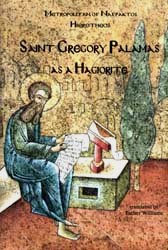by Metropolitan Hierotheos Vlachos
 His Eminence Metropolitan Hierotheos (Vlachos) of Nafpaktos serves the Metropolis of Nafpaktos in the Church of Greece. His study of the patristic texts and particularly those of the hesychast Fathers of the Philokalia, many years of studying St. Gregory Palamas, association with the monks of the Holy Mountain (Mount Athos), and many years of pastoral experience, all brought him to the realization that Orthodox theology is a science of the healing of man and that the neptic fathers can help the modern restless man who is disturbed by many internal and existential problems. In his books, he conveys the Orthodox spirit of the Philokalia to the restless and disturbed man of our time. This is why they have aroused so much interest.
His Eminence Metropolitan Hierotheos (Vlachos) of Nafpaktos serves the Metropolis of Nafpaktos in the Church of Greece. His study of the patristic texts and particularly those of the hesychast Fathers of the Philokalia, many years of studying St. Gregory Palamas, association with the monks of the Holy Mountain (Mount Athos), and many years of pastoral experience, all brought him to the realization that Orthodox theology is a science of the healing of man and that the neptic fathers can help the modern restless man who is disturbed by many internal and existential problems. In his books, he conveys the Orthodox spirit of the Philokalia to the restless and disturbed man of our time. This is why they have aroused so much interest.
This is an excerpt from his book “St. Gregory Palamas as a Hagiorite.”
However, in saying that St. Gregory is one who expresses the hesychastic life of the Holy Mountain, we must examine just what hesychia is according to the orthodox teaching.
Hesychia, stillness, is essential for man’s purification and perfection, which means his salvation. St. Gregory the Theologian says epigrammatically:
“One must be still in order to have clear converse with God and to bring the nous a little away from those wandering in error”
Through hesychia a man purifies his heart and nous from passions and thus attains communion and union with God. This communion with God, precisely because it is man’s union with God, also constitutes man’s salvation.
Hesychia is nothing other than “keeping one’s heart away from giving and taking and pleasing people, and the other activities”. When a person frees his heart from thoughts and passions, when all the powers of his soul are transformed and turned away from earthly things and towards God, then he is experiencing orthodox hesychia. St. John of the Ladder writes that stillness of soul is “the accurate knowledge of one’s thoughts and is an unassailable mind”. Therefore hesychia is an inner state; it is “dwelling in God”.
Of course the holy Fathers distinguish between external and internal stillness. External stillness is liberation of the senses and the body from sights, and particularly from the bondage which the world imposes, while inner stillness is liberation of the heart from images, fantasies and worries. Hesychia of the body is usually the hesychastic position and the person’s attempt to limit as far as possible external representations, the images which our sensations receive and offer to the soul. Hesychia of the soul implies that the nous is able not to accept any temptations to stray. In this way man’s nous escapes from the outer world and enters his heart, which is where it really belongs. Thus a person acquires peace in his heart, and there God Himself is revealed.
As we have seen, St. Gregory Palamas lived this orthodox hesychia. At first he looked for a secluded spot on the Holy Mountain and prayed to God night and day. Then he attained inner hesychia as well. Within this spiritual hesychastic atmosphere he acquired the knowledge of God, at the time when the heresy appeared which sought to unsettle the fundamental aspects of the Church’s teaching. It was just then, since he had experience of this life, that he expressed it.
It is only in this light that we must look at the life of St. Gregory. He was not just a student of the holy Fathers, but one who had the same life, and therefore also the same teaching as they.
In all his teaching we see the Hagiorite hesychast father who knows what hesychasm is, but above all, lives it. We can see this more analytically at two main points. First, in his dispute with Barlaam, and secondly in his homilies to the Flock of Thessaloniki, when he was made Archbishop of Thessaloniki, as well as in other related homilies.
